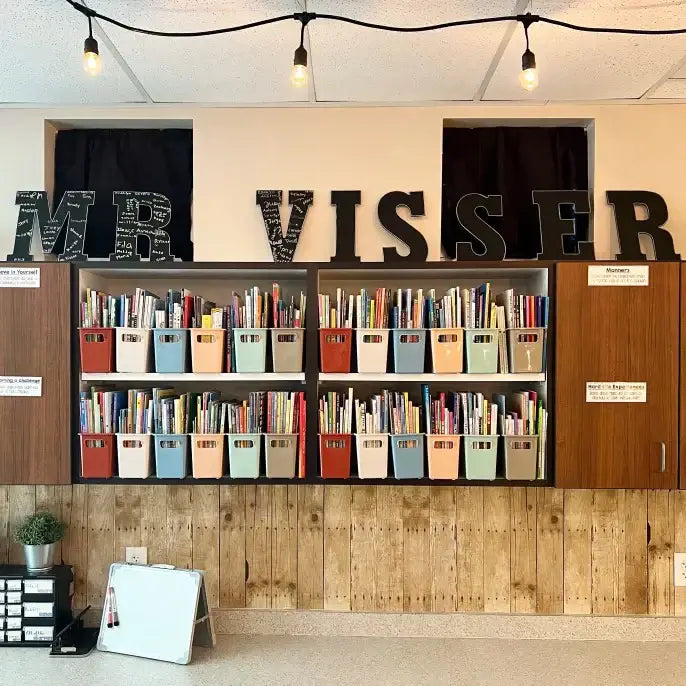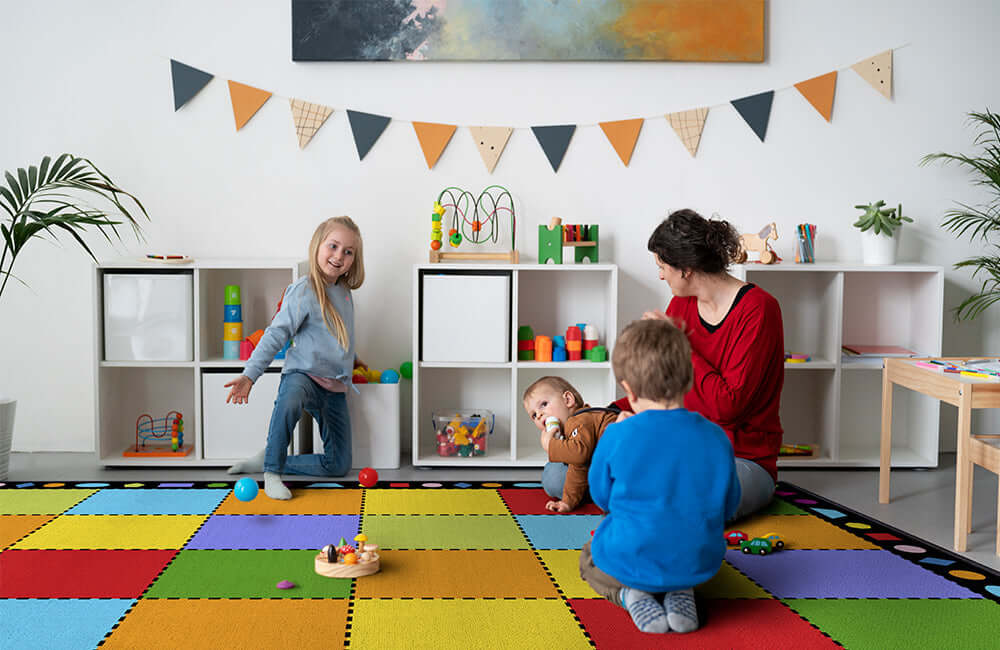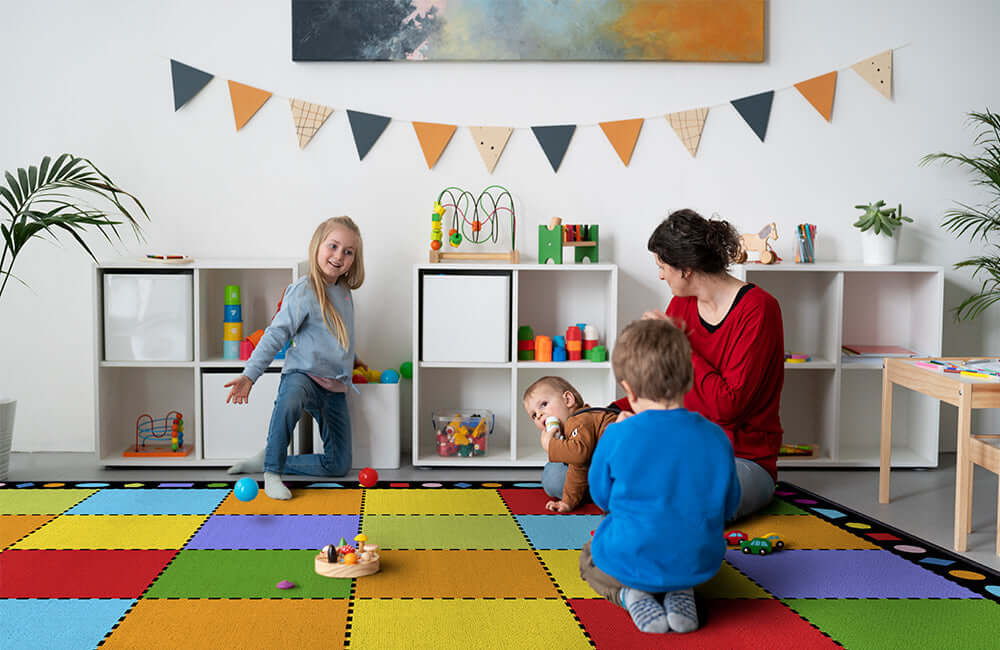The Science Behind Space: How Design Impacts Young Minds
Neurological Responses to Environment
When children enter a learning space, their brains immediately assess the environment for safety, comfort, and stimulation levels.
According to educational psychology research, well-designed classrooms can improve academic performance by up to 25%.
The tactile, visual, and spatial elements of classroom rugs play a significant role in this improvement.
The Psychology of Floor Learning
Floor-based learning activates different neural pathways than desk-based work. Children naturally gravitate toward floor spaces for:
- Collaborative activities: Promoting peer interaction
- Independent reading: Creating personal comfort zones
- Group discussions: Fostering equality and openness
- Movement-based learning: Supporting kinesthetic learners
Color Psychology in Educational Rugs
Cognitive Impact of Color Choices
The colors in classroom rugs directly influence students' psychological states. Research from color psychology experts demonstrates specific effects:
Blue Tones: Enhance focus and mental clarity
- Ideal for reading corners
- Promotes calm during testing
- Reduces hyperactivity
Green Shades: Support concentration and reduce eye strain
- Perfect for study areas
- Encourages creativity
- Creates natural balance
Warm Colors (controlled amounts): Stimulate engagement
- Energizes morning circles
- Promotes discussion
- Increases participation
Neutral Bases: Provide visual rest
- Reduces overstimulation
- Allows focus on learning materials
- Creates professional atmosphere
Spatial Psychology: Defining Learning Zones
The Power of Designated Spaces
Educational rugs serve as psychological boundaries that help children understand and navigate different learning modes:
- Create community gathering points
- Establish equality (everyone on same level)
- Foster inclusive discussions
- Build classroom culture
Reading Corner Rugs
- Signal quiet, reflective time
- Provide physical comfort for extended focus
- Create "special" spaces that make reading appealing
- Offer sensory comfort through soft textures
Learning Center Rugs
- Define activity boundaries
- Reduce noise transmission
- Organize classroom flow
- Support station-based learning
Sensory Integration and Learning
Tactile Elements in Education
The texture and feel of classroom rugs provide crucial sensory input that supports learning, especially for:
Sensory-Seeking Students
- Deep pressure from sitting on firm rugs
- Texture variety for tactile exploration
- Movement opportunities during carpet time
Sensory-Sensitive Students
- Predictable, soft surfaces
- Reduced acoustic stimulation
- Defined personal space
Research from occupational therapy professionals shows that appropriate sensory input through environmental design significantly improves attention and learning outcomes.
Pattern Psychology: Beyond Decoration
Educational Patterns That Enhance Learning
Alphabet and Number Rugs
- Create ambient learning opportunities
- Support kinesthetic learning through movement games
- Provide visual references during activities
- Build foundational academic skills
- Develop spatial awareness
- Support mathematical thinking
- Create visual order
- Reduce anxiety through predictability
Nature-Inspired Designs
- Reduce stress through biophilic elements
- Improve creativity and problem-solving
- Connect indoor and outdoor learning
- Support environmental education
Size and Scale: Psychological Comfort
Creating Appropriate Proportions
The size of classroom rugs impacts psychological comfort:
- Foster community building
- Support whole-class activities
- Create inclusive environments
- Establish classroom identity
Smaller Zone Rugs
- Provide intimate learning spaces
- Support individual or small group work
- Create retreat spaces for overwhelmed students
- Define specific activity areas
The Hidden Curriculum of Classroom Rugs
Teaching Through Environment
Quality classroom rugs communicate unspoken lessons:
Organization Skills
- Visual boundaries teach spatial awareness
- Designated areas promote tidiness
- Clear zones support transition skills
Social Skills
- Sharing carpet space teaches boundaries
- Circle arrangements promote eye contact
- Group seating encourages collaboration
Self-Regulation
- Quiet zones signal behavior expectations
- Comfort promotes emotional regulation
- Defined spaces reduce anxiety
Age-Appropriate Design Psychology
Early Childhood (Ages 3-6)
Young learners need:
- High contrast patterns for visual development
- Simple, clear designs to avoid overstimulation
- Soft textures for comfort and security
- Bright, engaging colors to maintain interest
Elementary (Ages 6-11)
Growing minds benefit from:
- Educational content integrated into design
- Flexible spaces for varied activities
- Durability for active use
- Sophisticated patterns that grow with students
Middle School (Ages 11-14)
Adolescent learners require:
- Mature designs that respect their development
- Flexible seating options for choice
- Neutral bases with accent colors
- Professional appearance for serious learning
Cultural Considerations in Design
Inclusive Environmental Design
According to multicultural education experts, inclusive classroom design should:
- Reflect diverse cultural patterns
- Avoid culturally specific symbolism that excludes
- Include universal design elements
- Celebrate diversity through thoughtful choices
The Teacher's Perspective: Practical Psychology
Supporting Educator Needs
Well-designed classroom rugs support teachers by:
- Reducing behavior management needs
- Creating natural gathering points
- Supporting diverse teaching methods
- Minimizing transition time
Flexibility for Different Learning Styles
Versatile classroom rugs accommodate:
- Visual learners (patterns and colors)
- Kinesthetic learners (movement opportunities)
- Auditory learners (acoustic benefits)
- Tactile learners (texture variety)
Maintenance Psychology: Cleanliness and Learning
The Impact of Clean Environments
Research from public health education sources shows clean classrooms:
- Reduce illness-related absences
- Improve concentration
- Increase respect for learning environment
- Model good hygiene habits
Choosing Easy-Care Options
- Stain-resistant classroom rugs reduce teacher stress
- Quick-dry features prevent mold issues
- Durable construction maintains appearance
- Simple cleaning supports daily maintenance
Budget-Conscious Psychology
Maximizing Impact Within Constraints
Strategic rug selection can:
- Transform spaces without renovation
- Create multiple learning zones affordably
- Last multiple school years
- Provide high visual impact per dollar
Implementation Strategies
Introducing New Rugs Effectively
- Involve students in placement decisions
- Establish rules for rug use together
- Create excitement about new learning spaces
- Model appropriate use and care
Seasonal Adjustments
Consider rotating rugs to:
- Maintain novelty and interest
- Align with curriculum themes
- Refresh classroom energy
- Accommodate weather changes
Measuring Success: Psychological Indicators
Observable Improvements
Well-chosen classroom rugs contribute to:
- Increased time on task
- Improved classroom community
- Reduced behavioral issues
- Enhanced student engagement
- Better organization skills
- Increased reading time
- More collaborative work
Future-Forward Classroom Design
Emerging Trends in Educational Spaces
Modern classroom design incorporates:
- Flexible learning environments
- Technology integration zones
- Mindfulness and calm-down areas
- Indoor-outdoor connections
- Sustainable materials
Conclusion: The Foundation of Learning
The psychology of classroom design reminds us that every element in a learning space sends messages to young minds.
Thoughtfully selected classroom rugs serve as more than functional floor coverings—they create the psychological foundation for engaged, comfortable, and effective learning.
By understanding and applying design psychology principles, educators can transform their classrooms into environments where every child has the opportunity to thrive.
Whether creating a cozy reading nook, an engaging circle time space, or defined learning centers, the right rug choices support both the educational goals and emotional needs of students.
In the end, these carefully considered design decisions contribute to creating classrooms where learning feels natural, enjoyable, and achievable for all.




Leave a comment
This site is protected by hCaptcha and the hCaptcha Privacy Policy and Terms of Service apply.